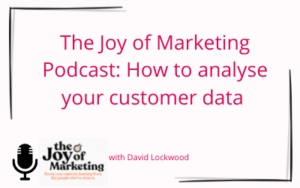David Lockwood, Tapestry Insight Director says:
When contemplating opening up new markets, companies naturally look across the pond to the US. It has three distinct advantages. They speak English, it’s a big – I mean very big – market and they do have a soft spot for us in Blighty. So why would you not take advantage of this?
As long as you have thought about the basics – you’ve determined from a business perspective why you want to be in that market, and you have a strong brand proposition – then what’s stopping you?
From my experiences of launching businesses and managing US marketing teams, here are my tips to bear in mind when planning moving Stateside.
Fly the flag. Britishness sells in the US – but you must determine what ‘British’ means to you. Is it the Union Jack? Is it history and tradition? Or is it London cool and cutting-edge design? Whatever it is, create a British manifesto for your brand. Then make sure your teams are all aligned and communicate it consistently across your US marketing.
The fundamentals of marketing still apply. Yes, it’s a different market, but when it comes to marketing, stick to the basics. Be smart. Test everything, analyse results and then roll out what you’ve learnt. For example, you won’t know what brand messaging resonates with a US audience, so replicating the messaging you use here may not work. Test your current messaging alongside other copy variations on short-term Facebook ads to see what is driving responses and hone these messages for your broader US marketing activity.
Speak the lingo. Adapt your language for the market to make it easy for them. Lose the ‘u’ in certain words; use ‘pants’ not ‘trousers’; price in dollars, not pounds and quote US sizes. These are just a few ways to show you respect your audience. Adaptations like these highlight attention to detail, commitment to the market and give US consumers the confidence to buy from you.
Choose the right channels. Pay Per Click (PPC) is a great channel to begin with in the US. However, you need to be mindful of the differences here. Getting the language right (see above) is essential for PPC and SEO while you need to ensure how you approach landing pages and reviews is correct. To avoid mistakes, use a US-based agency to support your PPC strategy. And when it comes to websites, having a dedicated country website rather than an extension to your UK site can help with US email deliverability.
Mail works well……..Catalogues are effective in the US, and there are a wealth of data and mailing lists available to drive targeting, with five data cooperatives to choose from – each with a slightly different focus. Ensure your US catalogues are as efficient as possible (e.g 24 pages of text with a 4 page (heavier paper) cover) so you can afford to mail more to make the most of this channel. While the preference in the US is for a lighter paperweight, going for a heavier stock can make you stand out and emphasise Britishness.
….but is expensive. With high postal rates, you should consider ‘commingling mail’ to reduce costs. Commingling is a service that bundles mailing items from multiple companies targeting the same zip code. Combining these different mail items from various brands helps achieve the United States Postal Service discounts, saving you money.
….and you must factor in delivery lags. The sheer size of the US means it takes much longer for a mailing to drop. Factor this into your response curves, so you don’t panic when things don’t appear to be working in the same as in the UK.
Inserts don’t work. Well, they might, but it’s hard to prove their value. With a lack of regulation of the channel and quoted circulation figures including free copies, you’ll struggle to get inserts in the US to work. Focus on other avenues that can be appropriately measured.
Free delivery is a table stake. US customers expect free delivery, and it’s an essential factor in encouraging that that first purchase, so offer it. There is also the expectation you will provide package tracking. Providing this not only reduces WISMO (Where is my Order) issues, but analysis has also shown that it helps increase loyalty and lifetime value.
Have a dedicated US phone number. Not only does this remove a barrier to response and provides a better customer experience, it also allows you to track US acquisition campaigns separately. One benefit the UK has over many countries is the fact we can service US customers during their core times. Work with partners here that can offer you an overflow service to support US calls during our evening. And even though there is a preference for transacting online, if an American customer needs to phone and then hears an English accent, this can endear them to you!
Find your price of success. An easy, but often overlooked, approach to pricing in the US is to look at how your UK competitors are pricing. There’s no harm at all in following suit. Many brands will price higher in the US, and US customers will pay more for Britishness or uniqueness.
There’s no substitute for local knowledge. If you were launching in Japan, it’s obvious you’d want to work with people who understand the market. Just because this is the English-speaking US, this logic still applies. Consumers in different parts of the US have different purchasing patterns. For example, people in the South buy more Thanksgiving gifts than those in the North, who buy more presents at Christmas. The US also has a host of unique gifting occasions, such as college or high school graduation in May, which offer important selling opportunities. Understand these nuances requires local knowledge (even think about running your marketing ideas past a US native) which is essential if you want to maximise your opportunities – and market correctly.
We’ve already helped clients successfully launch into the US and are exploring international expansion with others. So, if you’re contemplating a move abroad, get in contact, and we’d be more than happy to discuss how we can support you and make your foray into the US a success.




